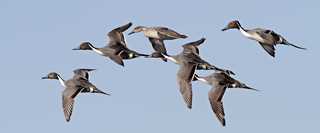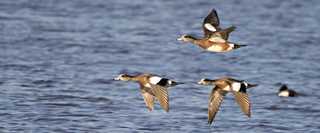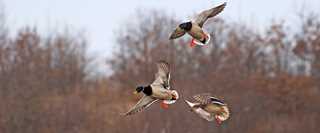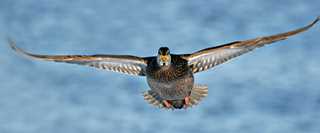2016 Waterfowl Forecast
Another large fall flight is on its way as duck and goose populations remain strong
Another large fall flight is on its way as duck and goose populations remain strong

One of the most anticipated events of the year for many duck hunters is the annual release of waterfowl breeding population estimates and habitat assessments. This information is compiled during extensive air and ground surveys conducted by the U.S. Fish and Wildlife Service (USFWS) and Canadian Wildlife Service in cooperation with state and provincial agencies, Ducks Unlimited, and other partners. In the past, the survey results were released in early July shortly after the surveys were conducted, but starting this year the release date was moved back until early August. The new reporting schedule was brought about by changes made last year to the way waterfowl hunting regulations are set.
As in the past several years, the 2016 waterfowl survey results contained plenty of good news for hunters and other waterfowl enthusiasts. According to the USFWS, duck numbers in the traditional survey area were statistically similar to last year's estimate and just shy of the record. Total populations were estimated at 48.4 million breeding ducks, which is 38 percent above the 19552015 average. With the exception of northern pintails, populations of the 10 most abundant duck species were at or above their long-term averages. In addition, the projected mallard fall flight index is 13.5 million birds, almost unchanged from the 2015 estimate of 13.8 million birds.
Although large numbers of ducks and geese returned to the breeding grounds this spring, wetland conditions were initially less favorable for waterfowl production across much of the Prairie Pothole Region. May pondsthe unit of measure for wetland abundance on the prairies decreased 21 percent in 2016, from almost 6.3 million ponds in 2015 to approximately 5 million ponds this spring. The total May pond count remained near the long-term average, however, largely due to carryover water stored in wetland basins from the previous year. Faced with drier conditions on the prairies, many waterfowl continued migrating north to breeding areas in the Boreal Forest and Arctic.
In light of the dry conditions that were observed during the survey period, it is reassuring to see that the breeding population counts were little changed from last year's, says DU Chief Scientist Dr. Scott Yaich. What's not reflected in the report is that the outlook for waterfowl production improved significantly after the surveys were completed. On some key waterfowl breeding areas in Prairie Canada, heavy June and July rains greatly improved wetland conditions. This likely benefited brood-rearing and the success of late-nesting species, and also gave a boost to overall production through re-nesting by early-nesting species.
Watching the changes in habitat conditions over the spring and summer this year underscores the importance of two things: First, we must simply accept that habitat and duck populations are going to vary over time. They always have, and they always will. Second, that's why we need to keep a steady hand on the course of our conservation efforts. Our job is to continually make deposits into the habitat bank account so that when precipitation and other conditions are right, the ducks will do the job they do so well, which is to produce more birds and provide us all with a nice return on our investments.
Although annual changes in duck and goose numbers have important implications for waterfowlers, they do not necessarily influence individual hunting success. Weather and local habitat conditions often affect the fortunes of waterfowlers more than the size of the fall flight, especially in migration and wintering areas. With that in mind, the following is a report on waterfowl populations in each flyway, based on reports from government and DU biologists in the field.

Photo Michael Furtman
The majority of Pacific Flyway waterfowl are raised on the prairies of the United States and Canada, northwestern Canada, Alaska, and other western states. In southern Alberta, below-average winter snowfall and little runoff resulted in a 26 percent decrease in May ponds in this region. Total breeding ducks were down 11 percent in the region from the 2015 estimate, but remained 17 percent above the long-term average. In June and July, torrential rains fell across much of Alberta, raising water levels in existing wetlands and refilling some wetlands that had been dry in the spring.
Locally heavy rainfall associated with thunderstorms put water in the fields in some areas, reports DU Canada biologist Ian McFarlane. Frequent rainfall and high humidity delayed the hay harvest and enhanced forage growth, which benefited nesting ducks. Our field staff reported numerous broods with good numbers of ducklings in many areas. As a result, waterfowl production should be better than originally anticipated, but still likely below 2015 levels.
Farther north, in the Boreal Forest of northern Alberta, northeastern British Columbia, and the Northwest Territories, the abundance of breeding ducks increased 22 percent in 2016 and was 93 percent above the long-term average. In Alaska and the Yukon, breeding ducks were up 28 percent this year and were 17 percent above the long-term average. The increase in waterfowl numbers surveyed on these northern breeding areas likely reflected a partial redistribution of waterfowl from the prairies.
DU Canada biologist Jamie Kenyon reports that wetland conditions were generally favorable for breeding waterfowl across much of the Western Boreal Forest. Following an early spring, temperatures were warmer than average this summer, Kenyon says. Heavy rains in June and July brought pond levels up across much of the region, although rainfall was below average in parts of northern Alberta and the southern Northwest Territories. Overall, habitat conditions were favorable for brood rearing, and larger wetlands should provide good habitat for staging waterfowl this fall.
In the western United States, much-needed precipitation improved wetland conditions in parts of the region this spring, but waterfowl habitats continue to suffer the effects of drought in many areas. In California, total ducks were up 30 percent compared to the 2015 estimate, but remained 27 percent below the long-term average. In Oregon and Washington, duck populations were down 24 percent and 37 percent, respectively, despite some improvement in wetland conditions.
Weather and habitat conditions were excellent for most Pacific Flyway goose populations. An exceptionally early spring thaw in Alaska's Yukon-Kuskokwim Delta and other important northern breeding areas likely resulted in good production of cackling, Ross's, and white-fronted geese as well as Pacific brant.

Photo Michael Furtman
The Central Flyway receives most of its waterfowl from the prairies, with large numbers of ducks coming from Saskatchewan, eastern Alberta, North and South Dakota, and eastern Montana. In Saskatchewan, May ponds were down 19 percent this spring. Total duck numbers decreased 21 percent from the 2015 estimate, but remained 37 percent above the long-term average. As in Alberta, late spring and summer rains improved habitat conditions for breeding waterfowl in Saskatchewan after waterfowl surveys were conducted.
June brought frequent heavy rains to Saskatchewan, which continued through July, causing localized flooding of roads and dwellings, reports DU Canada biologist John Trevor. Wetlands are now at or above capacity in many areas. Our field staff have observed numerous waterfowl broods in all areas of the province, indicating good waterfowl production.
In the north-central United States, returning waterfowl found drier habitat conditions across much of the region this spring. In the eastern Dakotas, breeding duck numbers were similar to last year's estimates and remained 37 percent above the long-term average. In the western Dakotas and Montana, duck numbers were down 18 percent, but remained 29 percent above the long-term average.
Dry to average wetland conditions prevailed this summer across the most important waterfowl breeding areas of North Dakota, South Dakota, and eastern Montana, reports Kaylan Carrlson, DU's manager of conservation planning in the Great Plains region. Although breeding pair numbers remained above average in the region, less wetland habitat on the landscape may result in decreased duck production compared to last year.
Central Flyway goose populations remain healthy. On the prairies, populations of large subspecies of Canada geese remain well above their long-term averages, and average to good production of these birds is expected. In the Arctic, production of cackling, Ross's, lesser snow, and white-fronted geese should be comparable to or better than last year.
Remember: Weather and local habitat conditions often affect the fortunes of waterfowlers more than the size of the fall flight.

Photo Michael Furtman
The majority of Mississippi Flyway waterfowl are raised on the prairies of the United States and Canada, as well as in the Western Boreal Forest, southern and central Ontario, and the Great Lakes states. In southern Manitoba, ample carryover water and timely spring rains resulted in a 17 percent increase in May pond numbers, which were near the long-term average overall. Total breeding ducks in this region were down 11 percent this spring, but remained 15 percent above the long-term average.
DU Canada biologist Lena Vanden Elsen reports that late spring and summer weather improved prospects for waterfowl production in southern Manitoba this year. The southwestern portion of the province received several significant precipitation events beginning in mid-June and continuing into July, Vanden Elsen reports. Grassland cover for nesting waterfowl was lush, and haying operations were delayed because of the rain. In late July, our field staff were still observing large numbers of broods of various ages, indicating a strong breeding effort among both early- and late-nesting species. Brood survival was also expected to be good this year, as wetlands and upland vegetation were in good condition.
The waterfowl production outlook was variable in neighboring Ontario, which is an important breeding ground for the Mississippi and Atlantic Flyways. In June, the temperature warmed up across Ontario, and for much of southern and central Ontario, an extended period of drought began, says DU Canada biologist David McLachlin. Conversely, reports indicated that wetland conditions were more favorable across northern Ontario, with abundant precipitation on the Hudson Bay coast to more variable amounts across the Boreal zone. While drought across the south limited seasonal wetland habitat for breeding pairs, many larger brood-rearing wetlands have withstood the lack of precipitation. In the north, field reports indicate that habitat conditions were generally favorable for breeding pairs and broods.
Ducks and geese raised in the Great Lakes states make an important contribution to waterfowl populations locally and throughout the eastern Mississippi Flyway. In Minnesota, total duck numbers were up 47 percent this spring and were 25 percent above the long-term average. In Michigan and Wisconsin, duck populations were largely unchanged from the previous year's estimates and their respective long-term averages. As in southern Ontario, dry spring and summer weather likely impacted waterfowl production in the Great Lakes states in 2016.
Abnormally dry conditions persisted throughout much of the brood-rearing period across a substantial portion of the Great Lakes region, reports Dr. John Coluccy, director of conservation planning in DU's Great Lakes/Atlantic Region. These conditions likely hampered brood survival and renesting efforts to some degree.
This was a good year for most Mississippi Flyway goose populations. Weather conditions in the central Arctic were generally favorable for breeding waterfowl, and average to above-average production of lesser snow, Ross's, and white-fronted geese is expected this year. Excellent production was reported among giant Canada geese, while inclement weather on northern breeding areas may have adversely affected breeding success for Mississippi Flyway Interior Population Canada geese, which include birds from the Southern James Bay, Mississippi Valley, and Eastern Prairie populations.

Photo Michael Furtman
The majority of Atlantic Flyway waterfowl are raised in the eastern United States and Canada, with the exception of certain species, such as canvasbacks and redheads, which are largely derived from the prairies. Waterfowl populations and habitat conditions in the Atlantic Flyway tend to be relatively stable over time and don't experience the same drought cycles as the prairies. In the eastern survey area (eastern Ontario, Quebec, the Maritimes Provinces, Maine, and northern New York) the abundance of American black ducks was up 13 percent compared to the previous year's estimate and was similar to the long-term (19902015) average. Breeding populations of other common duck species in this region including mallards were unchanged in 2016 and remained near their long-term averages. In areas of the northeastern United States surveyed by state wildlife agencies, total duck numbers were similar to last year's estimate and the long-term average.
DU Canada biologist Nic McLellan reports that weather and habitat conditions were generally favorable for breeding waterfowl in Atlantic Canada. Little spring runoff and no flooding resulted in early brood production among mallards and black ducks, McLellan says. Waterfowl production appears to have been good overall, as young broods of later nesters (ring-necked ducks, American wigeon, and green-winged teal) were still being observed in late July. Summer was generally dry and warm in the region, and our wetlands are still holding water at slightly-below-normal operating levels.
The forecast for Atlantic Flyway goose populations is generally positive. Breeding ground surveys indicate that Atlantic Population Canada geese and greater snow geese remain at high levels, and surveys indicate that these birds had fair production in 2016. Weather and habitat conditions were variable for Atlantic brant, but biologists reported good early nesting success on key breeding areas, which bodes well for production of these birds.
Ducks Unlimited uses cookies to enhance your browsing experience, optimize site functionality, analyze traffic, and deliver personalized advertising through third parties. By continuing to use this site, you agree to our use of cookies. View Privacy Policy